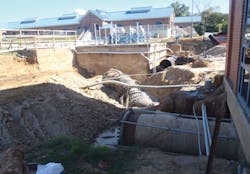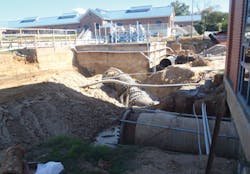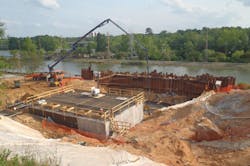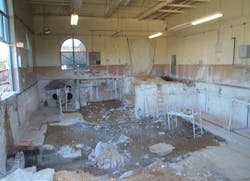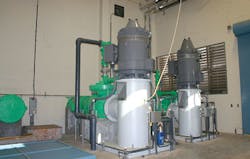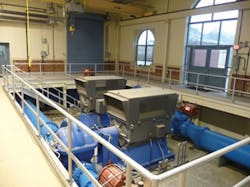City of Columbia's Water Treatment Plant Upgraded to Increase Pumping Capacity
By Craig Metts
The Canal Water Treatment Plant (WTP), located in the city of Columbia, S.C., was in need of raw water and high-service improvements to increase the capacity of its facilities and improve the overall operational reliability of the system. The raw-water pumps, high-service pumps, high-service yard piping, and associated appurtenances had reached the end of their expected useful life and were beginning to experience failures.
URS, working in tandem with Columbia's WTP and engineering staff, developed a complex and detailed construction sequencing methodology that would meet multiple project requirements. The city set forth design requirements that included minimizing interruptions to normal daily WTP operations as well as maintaining a minimum production capacity of 50-million-gallons-per-day (MGD) at any given time during construction.
In order to ensure that these goals would be achieved, a plan was implemented to evaluate the condition of existing high-service piping yard valves. Each valve was operated by city staff, and the functional condition and anticipated ability to isolate flow was captured in a valve schedule.
Utilizing the data from the city, a detailed construction sequencing plan was developed that broke down the replacement of the existing high-service pumps and piping into manageable steps that would meet the objective of maintaining a minimum discharge capacity from the WTP at any given time. The detailed description of these steps and objectives, as well as plan sheets showing the step-by-step progression of the high-service piping work, were included as part of the bid documents.
Design Upgrades
The three existing raw-water pump stations located along the bank of the Columbia Canal were replaced with a single raw-water pump station that includes four vertical turbine pumps with a slot for one future pump. The two 700-hp pumps and two 350-hp pumps operate on medium-voltage motors driven by variable frequency drives (VFDs).
The raw-water pump station is designed to provide Columbia with a current reliable capacity of 85 MGD and an ultimate reliable capacity of 120 MGD. The VFDs provide the ability to vary the flow capacity depending on demand, therefore conserving energy. The raw-water pumping improvements also included a new passive intake bar screen structure sized for 120 MGD with a maximum approach velocity of 0.5 feet per second.
The improvements to the city's high-service pumping facility included the removal of three existing pumps (originally commissioned in 1953) with a total combined pumping capacity of 25 MGD. The pump room was retrofitted with two horizontal split-case pumps, each with a pumping capacity of 25 MGD. The pumps operate on 2,000-hp motors driven by medium-voltage VFDs. Additional improvements included the conversion of one of the plant's electrical substations from 2,300 to 4,160 volts and the addition of a 3-MW diesel generator capable of paralleling with the utility service.
Unique Devices
In order to make the needed improvements to High Service Pump Room No. 1, it was necessary to retrofit the structure to accommodate equipment and appurtenances to increase the pumping capacity from 25 MGD to 50 MGD while maintaining the historic value of the building.
The existing structure included a main-level pump room with a basement area that provided access to piping. The design required demolition of the entire interior of the room, including the main-floor level, and construction of the new pump room from the basement level upwards. All of the improvements were made on the interior of the structure while keeping the historical exterior features fully intact.
Another unique element worked into the project related to the plant staff's ability to anticipate changing water quality conditions in the Canal raw water source, which is directly influenced by the Broad River. The river flows uninhibited from the Parr Reservoir, located 25 miles northwest of Columbia, to the head of the Canal, which lies 2.4 miles upstream of the WTP.
During heavy rain events, the water source has been susceptible to rapid and prolonged changes in quality, peaking as much as 10 times the average turbidity level. The ability to anticipate these changes in water quality provides plant staff an opportunity to set forth operational changes at the facility so that the finished water quality is not adversely affected.
Through coordination with the U.S. Geological Survey (USGS), Columbia was able to negotiate an agreement to make improvements to one of USGS's water-quality monitoring stations located upstream of the WTP's raw water intake. The existing station gathered data and periodically reported the information back to a database, which it would then upload to a website. As part of the project, improvements were made to the station to increase the sampling capabilities of the equipment and to establish threshold limits for specific water quality parameters that would trigger quicker reporting intervals.
Complex Challenges
Among the particularly complex project challenges that needed to be managed were:
- The age of the Canal WTP: The Canal WTP originated in 1906. Significant research, data collection and field verification were required to develop as-built plans for existing infrastructure and to produce an accurate basis from which to begin design.
- Isolation of valves for pipe replacement: A plan was developed in collaboration with WTP staff to identify operable valves that could be utilized in the detailed construction sequencing plans. Likewise, a plan to replace inoperable valves was also developed.
- Maintaining a minimum 50-MGD plant capacity throughout construction: A detailed sequence of construction documents was prepared, and temporary high-service and raw-water pumping facilities were designed, including temporary electrical feeds, to ensure that minimum requirements could always be met.
- Repair of failing stormwater tunnel beneath high-service yard piping: An in-situ external structural remediation plan was designed for the tunnel, which was set to be constructed as new piping was installed. However, once excavated, the tunnel was found to be in worse shape than anticipated. An expedited design of an alternate structural repair method was devised that consisted of an internal repair to the tunnel.
- Construction within the Canal waterway: Due to the potential presence of shortnose sturgeon in the Canal, no construction was permitted during the spawning season (March through June). A cofferdam had to be constructed to isolate the intake construction zone from the waterway so that construction could continue apace.
As a result of the close collaboration with Columbia and the development of detailed construction sequencing documents, there was no interruption of water service to customers served by the Canal WTP throughout the course of the project. The continuation of service was of particular importance, given that the Canal WTP provides water to approximately 375,000 customers, including three hospitals, the Westinghouse Nuclear Station, Fort Jackson, and McEntire Joint National Guard Base.
About the Author: Craig Metts is a senior project manager with URS Corporation (Columbia, S.C.), a leading provider of engineering, construction and technical services for public agencies and private sector companies around the world.
More WaterWorld Current Issue Articles
More WaterWorld Archives Issue Articles
